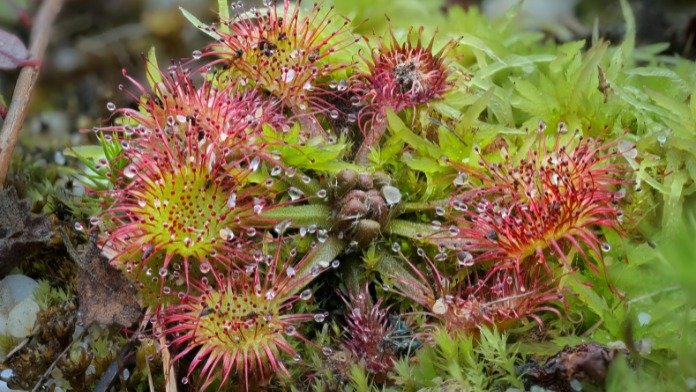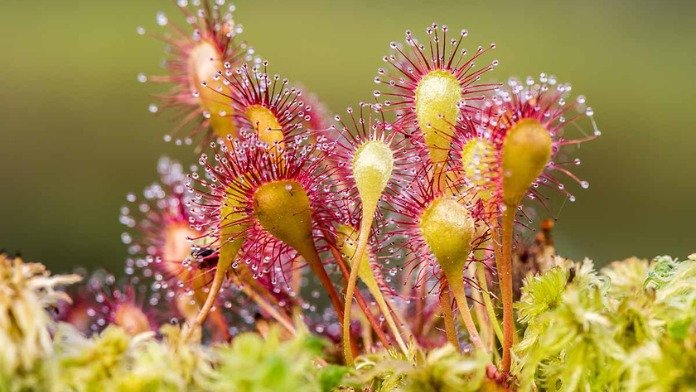
The carnivorous plant sundew, a wonder of the plant kingdom, captures the imagination with its unique adaptations and survival strategies. Belonging to the genus Drosera, sundews are famous for their shiny, sticky trichomes that attract, trap and digest unsuspecting insects.
In this comprehensive guide, we’ll delve into the complex world of the sundew plant, exploring its fascinating properties, ecological significance and cultivation. The Sundew (Drosera) is one of the most diverse carnivorous plants. In South Africa, you can find sundew plants such as Drosera capensis (Cape sundew) and Drosera aliciae, while in Australia, you can discover Drosera binata and various pygmy sundews.
What are Sundews?
Sundews are a type of carnivorous plant found in various habitats worldwide, from North America’s nutrient-poor peat bogs to Australia’s tropics.
Its distinguishing feature is the presence of glandular hairs or trichomes that secrete a sticky mucus. This mucus attracts insects and traps them, allowing the plant to absorb essential nutrients from its prey.
The Science Behind Sundews
The botanical name of the sundew plant is derived from the Greek word “droseros”, meaning “dew”. This is an apt description, as the plant’s trichomes glisten like morning dew.
Sundews belong to the Droseraceae family, which includes several other genera of carnivorous plants. The genus Drosera is one of the largest in this family and contains over 200 species.
Capture Mechanism
The sundew capture mechanism is a wonderful example of nature’s ingenuity. Sundew leaf trichomes secrete a sweet-smelling mucilage that attracts insects. Once an insect lands on a leaf, it gets stuck in the sticky substance. The more the insect struggles, the more it becomes entangled.
Digestion and Absorption of Nutrients
After catching an insect, the Sundew begins the digestion process. The trichomes secrete digestive enzymes that break down the insect’s body and release important nutrients such as nitrogen, phosphorus, and potassium. The plant absorbs these nutrients, supplementing the poor soil conditions where Sundew is usually grown.
Types of Sundaes
Sundews exhibit tremendous diversity in form and function. Some notable types include:
Cape Sundew (Drosera capensis): Known for its long, narrow leaves and vibrant red trichomes, Cape Sundew is a popular species among carnivorous plant enthusiasts.
Round-leaved Sundew (Drosera rotundifolia): This species is characterized by its rounded, flattened leaves and is commonly found in wetlands of the Northern Hemisphere.
Spiny-leaf Sundew (Drosera binata): Spiny-leaf sundew has uniquely spiny leaves, distinguishing it from other species.
Ecological Significance
Drosera is an herb. The dried plant is used to drink Sundew as a tea for various respiratory ailments such as wheezing, asthma, whooping cough (whooping cough), windpipe infection (tracheitis), cough fits and dry cough. They also take it for stomach ulcers and cancer.
Habitat and Distribution
Sundew is found in various habitats and often thrives in environments where other plants struggle to survive. Its ability to obtain nutrients from insects allows it to colonize nutrient-poor soils, such as those found in peat bogs, bogs, and heathlands. Some species are also found in tropical rainforests, where they grow as epiphytes on other plants.
Role of Ecosystem
Sundews play an important role in their ecosystem by controlling insect populations. This helps maintain a balance within the local food web. Furthermore, sundews contribute to the biodiversity of their habitats, often coexisting with other specialized flora and fauna.
Conservation Status
Many sundew species are threatened by habitat destruction, climate change and illegal harvesting. Conservation efforts are underway to protect these unique plants and their habitats. Organizations and botanical gardens worldwide are working to cultivate and propagate sundews, ensuring their survival for future generations.
Cultivation and Care
Cape sundew (Drosera capensis) is the best carnivorous plant for beginners. It is easy to grow on windowsills or outdoor bogs in frost-free climates. Sundews are highly productive under artificial light, maximizing their jewel-like beauty.
Be sure to include soil in your plant order. If your minimum nighttime temperature is below 55°F (13°C), we recommend including a heat pack with your Tropical Sundew order.
Growing Sundews at Home

Growing Sundew can be a rewarding experience for plant enthusiasts. These impressive plants can be grown indoors or in the garden if their needs are met.
Here are some essential tips for successful sundew cultivation:
Light: Sundews need lots of sunlight to thrive. A south-facing window or dedicated grow light can provide the necessary light levels.
Soil: Use a nutrient-poor, well-draining soil mix, such as a combination of peat moss and perlite. Avoid using regular potting soil as it is too nutrient-dense for sunlight.
Water: Distilled or rainwater keeps the soil constantly moist. Tap water often contains minerals that can harm Sundew.
Humidity: Maintain high humidity levels, especially for tropical species. A humidity tray or regular misting can help achieve this.
Diet: Although sundews can catch prey, supplemental feeding with small insects can boost their growth. Avoid using fertilizers as they can be harmful to plants.
Propagation Techniques
Propagate by seeds as they mature. Stored seeds quickly lose their viability. Leaf cuttings during the growing season and root cuttings taken during dormancy are alternative propagation methods. A perfect plant for beginners! This wonderful sundae comes from the Cape in South Africa. It is a versatile species that offers everything a plant lover could ask for.
Cape sundews are large, beautiful plants that grow very easily. They produce dozens of lovely pink flowers on long stems and are easy to propagate. Its leaves move quite dramatically and tolerate a wide range of growing conditions.
They are by far the most entertaining and popular in Drosera. They will catch mosquitoes, fruit flies and flies. Several methods, including seeding, leaf cuttings and division, can propagate Sundew:
Seed: Sow sundew seeds on a moist, sterile substrate surface. Please keep them in a warm, well-lit environment. Germination may take weeks to months.
Leaf cuttings: Place a healthy leaf on a moist layer. In a few weeks, new shoots will grow from the leaves.
Division: Mature plants can divide at the roots to form new individuals. This procedure occurs during the plant’s active growing season.
Sundews in Culture and Science
Drosera (scientific name Drosera) is a plant that is not what it seems. At first glance, it looks like the embodiment of innocence, but woe to the vermin that allows itself to be trapped!
He was first tied with a sticky substance and then strangled to death. However, the Sundew is completely harmless to humans: it does not bite, and its red-brown sheen is beautiful.
Colour and Size
The Sundew grows in a colourful rosette and attracts, traps and digests insects with a shiny, sticky substance in the tentacles that form its sticky trap. Insects find these droplets irresistible, but they get stuck if they come in contact with them.
Once prey is captured, the leaf slowly wraps around to digest it. In nature, insects provide virtually non-existent nutrients in wetlands where plants live. Sundew flowers are white and much larger than the plant.
They only bloom for one day and remain open for about four hours. Even without a flower, sunlight is exceptionally photogenic.
Symbolism
The symbolic meaning of Sundew is “wonder” because nothing seems to be. The dew is sticky, the open leaves are a trap, and the plant looks very nice, but the insects don’t stand a chance. It’s all Alice in Wonderland, full of optical illusions and surprises.
Origin
Sundew is a genus of carnivorous plants in the sundew family of about 200 species. The scientific name Drosera is derived from the ancient Greek word “drosos” (dew) and refers to the shiny drops on the tentacles. Sunlight is born everywhere except Antarctica.
Historical Meaning
Sundews have intrigued botanists and naturalists for centuries. In the 18th and 19th centuries, they fascinated Charles Darwin, who conducted extensive research on their carnivorous behavior. Darwin’s observations of sundews contributed significantly to our understanding of plant adaptation and evolution.
Modern Research
Today, sundews continue to be the focus of scientific research. Studies of their capture mechanisms, digestive enzymes and ecological interactions provide plant physiology and ecology information. Sundews also have potential applications in biotechnology as natural pesticides and bioadhesives.
Droseras in Popular Culture
Sundews have appeared in literature, art, and media, often symbolizing the mystery and allure of the natural world. Their impressive appearance and unique lifestyle make them a popular subject for botanical illustrations and garden displays.
Conclusion
Carnivorous plant sundews are astonishing evidence of evolution and adaptation. Their captivating beauty, coupled with their ability to thrive in challenging environments, makes them a plant of interest to botanists, gardeners, and nature enthusiasts alike.
By understanding and appreciating sunlight, we can develop a deeper connection with the natural world and contribute to the conservation of these extraordinary plants. Whether grown at home or studied in the wild, sunlight delights and inspires, reminding us of the infinite variety and ingenuity of life on Earth.
FAQ
Is Sundew a Carnivorous Plant?
Sundews are plants that trap their prey in sticky hairs on their leaves. They form one of the most numerous groups of carnivorous plants.
Is the Sundew Plant Poisonous?
Unlike the famous sago palm or the deceptive death bed, Cape Sundew is not poisonous to humans.
Do you Need Help to Keep Sundews Alive?
Alice sundews, cape sundews, forkleaf sundews, spoonleaf sundews and lanceleaf sundews require similar easy growing conditions.
Does Sundew Plant Smell?
Its leaves, with tiny dew-like droplets, glisten in the sun, attracting small insects that look and smell like nectar.
How Long can a Sundew Live?
Drosera, commonly known as Sundew, is one of the largest genera of carnivorous plants. It is an erect herbaceous perennial or (more rarely) annual plant that forms prostrate or upright rosettes and can live up to 50 years.
RELATED POSTS
View all


